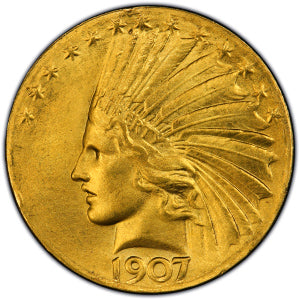

A comprehensive handbook for collectors, coin enthusiasts, and numismatic researchers alike.
Introduction
The $10 Indian Head Gold Eagle, designed by Augustus Saint‑Gaudens at the urging of President Theodore Roosevelt, is one of the most iconic U.S. gold coins. Struck from 1907 to 1933, this remarkable series represents Roosevelt’s “Renaissance of American Coinage.” Today, collectors and investors alike seek these coins for their artistry, rarity, and enduring value.
In this guide, you will learn everything about the $10 Indian Gold Eagle: its history, design, specifications, types, key rarities, grading tips, investment potential, and year‑by‑year collecting notes. Whether you are a new collector or an advanced numismatist, this article will serve as your authoritative reference.
Key Specifications of the $10 Indian Eagle
· Designer: Augustus Saint‑Gaudens
· Years of Issue: 1907–1916; 1920, 1926, 1930, 1932–1933
· Composition: 90% gold, 10% copper
· Gross Weight: 16.718 grams (0.5375 oz)
· Pure Gold Weight: 0.48375 troy oz
· Diameter: 27 mm
· Edge: Stars (46 stars until 1911; 48 stars from 1912 onward)
· Mints: Philadelphia (no mintmark), Denver (D), San Francisco (S)
Obverse and Reverse Design
· Obverse: Liberty wearing a Native American war bonnet, the word LIBERTY on the band, 13 stars above, and the date below.
· Reverse: A majestic eagle standing on arrows and an olive branch. Mottoes include E PLURIBUS UNUM and, from late 1908 onward, IN GOD WE TRUST.
This bold design broke from traditional Greco‑Roman themes and showcased Roosevelt’s vision for a uniquely American coinage.
Collectible Types of the $10 Indian Gold Eagle
1. 1907 Wire Rim (Rounded Edge) – Experimental issue with sharp rim fin; highly prized rarity.
2. 1907 Rolled Edge – Extremely rare, with only 40–50 known survivors.
3. 1907–1908 No Motto – Early circulation issues without IN GOD WE TRUST.
4. 1908–1933 With Motto – Final and most common subtype, featuring the restored motto and 48 stars after 1912.
Year‑by‑Year Collecting Notes
· 1907 Wire Rim & Rolled Edge: Trophy rarities, with the Rolled Edge among the greatest 20th‑century U.S. gold coins.
· 1908 No Motto (P & D): Short‑lived subtype; transitional appeal.
· 1911‑D: Major key date with very low survival in Mint State.
· 1920‑S & 1930‑S: Classic condition rarities, scarce in high grade.
· 1926 & 1932: Best options for affordable, high‑grade type coins.
· 1933: Nearly all were melted; surviving examples are legendary rarities.
Rarity Tiers
· Ultra‑Rarities: 1907 Rolled Edge, 1933 Indian Eagle.
· Keys: 1907 Wire Rim, 1911‑D, 1920‑S, 1930‑S.
· Better Dates: 1908‑S, 1909‑D, 1913‑S, 1915‑S, 1916‑S.
· Common Type Coins: 1926, 1932 and all other dates, unless in high grades.
Grading and Authentication Tips
· High‑Points to Check: Liberty’s cheek and brow, eagle’s breast and legs.
· Surface Issues: Bag marks common; seek coins with clean cheek and strong luster.
· Color: Original coins show rich orange‑gold or olive‑gold tones; avoid cleaned or altered pieces.
· Counterfeits: Watch for added mintmarks (especially 1911‑D). Always buy certified examples from PCGS, NGC, or CACG.
Proof Issues
· Years: 1908–1915 (Philadelphia)
· Finishes: Matte and Roman Proofs with granular texture and razor‑sharp rims.
· Rarity: All proofs are extremely scarce and highly desirable.
Collecting Potential
The $10 Indian combines:
- Gold Content: Almost half an ounce of gold.
- Numismatic Premiums: Strong demand across all grades.
- Long‑Term Growth: Roosevelt–Saint‑Gaudens pedigree ensures perpetual collector interest.
Common dates like the 1926 and 1932 provide affordable entry points, while trophy coins such as the 1907 Rolled Edge and 1933 Indian represent pinnacle purchases.
Collecting Strategies
· Beginner: Start with a 1926 or 1932 Indian Eagle in MS62–MS64.
· Intermediate: Build a four‑type set: Wire Rim, Rolled Edge, No Motto, With Motto.
· Advanced: Assemble a complete 33‑coin set by date and mint.
· Specialist: Pursue proofs or high‑grade gems with CAC approval.
Legacy of the $10 Indian Gold Eagle
The $10 Indian Head Gold Eagle is more than just a coin; it is a monument in miniature. Roosevelt’s vision and Saint‑Gaudens’ artistry created one of the boldest designs in U.S. numismatics. From the experimental 1907 issues to the rare survivors of 1933, this series continues to captivate collectors and investors worldwide.
Some Topics Covered:
· $10 Indian Gold Eagle
· Indian Head $10 gold coin
· 1907 $10 Indian Wire Rim
· 1907 Rolled Edge Eagle
· 1911‑D Indian Head Eagle
· $10 gold coin values
· Augustus Saint‑Gaudens coins
· U.S. gold coins 1907–1933

